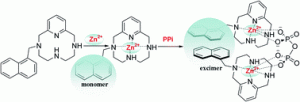In this Dalton Transactions Hot article, researchers at Nanjing University, China have developed a fluorescent sensor to detect the biologically important anion pyrophosphate.
Pyrophosphate in the body is integral to the production of ATP and DNA, and is involved in preventing the formation of hydroxyapatite in extracellular fluid. A lack of pyrophosphate leads to medial calcification, while an excess has been linked to calcium pyrophosphate dihydrate deposition disease, a form of rheumatism.
In this paper the authors make a ratiometric fluorescent sensor using a naphthalene appended tetraazamacrocycle (1)-Zn2+ complex. The sensor is not influenced by its environment, as the ratio of fluorescent intensities at two different wavelengths is measured, rather than using one lone fluorescence, as in the conventional method.
READ FOR FREE until January 20th.
 A Zn2+-specific turn-on fluorescent probe for ratiometric sensing of pyrophosphate in both water and blood serum
A Zn2+-specific turn-on fluorescent probe for ratiometric sensing of pyrophosphate in both water and blood serum
Jinghan Wen, Zhirong Geng, Yuxin Yin, Zhong Zhang and Zhilin Wang
Dalton Trans., 2011, Advance Article
DOI: 10.1039/C0DT01262A, Paper










